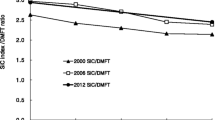Abstract
Aim
To present and analyse changes in caries prevalence and caries distribution in child population sample groups in the city of Jönköping, Sweden, based on investigations performed in 1973, 1978, 1983, 1993, 2003, and 2013.
Methods
At each investigation, the study population included about 500 randomly sampled individuals, divided into age groups of 3, 5, 10, 15, and 20 years. The oral health status of all individuals was clinically and radiographically examined by trained paediatric dentists.
Results
35% of the 3-year-olds were caries-free in 1973, compared to 79% 40 years later. Decayed and filled primary (dfs) and permanent (DFS) tooth surfaces were reduced by 67–90% between 1973 and 2013. Adolescents aged 10 and 15 years exhibited the most pronounced reduction in DFS on the occlusal surfaces. By 2013, more than 90% of the proximal caries lesions in 15-year-olds were initial lesions. About 85% of 15-year-olds had a DFS of ≤ 5, whilst 1% exhibited a DFS of ≥ 26. The corresponding figures for 1973 were 0 and 45% respectively. The DFS score for the 20-year-olds was 35.1 in 1973 and 5.8 in 2013. Caries-free 20-year-olds were not seen until 1993 and reached 19% in 2013.
Conclusions
Despite the dramatic decline in the prevalence of caries, caries still remains a health problem in a limited group of children, particularly those of pre-school ages. Repeated epidemiological studies are recommended to follow changes in oral health over time in order to evaluate existing preventive measures.





Similar content being viewed by others
References
Ahovuo-Saloranta A, Forss H, Walsh T et al (2013 ) Sealants for preventing dental decay in the permanent teeth. Cochrane Database Syst Rev (3):CD001830. doi:10.1002/14651858.CD001830.pub4.
Alm A, Wendt LK, Koch G, Birkhed D. Prevalence of approximal caries in posterior teeth in 15-year-old Swedish teenagers in relation to their caries experience at 3 years of age. Caries Res. 2007;41:392–8.
Amarante E, Raadal M, Espelid I. Impact of diagnostic criteria on the prevalence of dental caries in Norwegian children aged 5, 12 and 18 years. Community Dent Oral Epidemiol. 1998;26:87–94.
Bratthall D. Introducing the Significant Caries Index together with a proposal for a new global oral health goal for 12-year-olds. Int Dent J. 2000;50:378–84.
Declaration of Helsinki. Recommendations guiding physicians in biomedical research involving human objects. Adopted by the 18th World Medical Assembly, Helsinki, Finland, 1964. Amended latest by the 59th World Medical Assembly, Seoul, Republic of Korea, 2008.
Haugejorden O, Birkeland JM. Evidence for reversal of the caries decline among Norwegian children. Int J Paediatr Dent. 2002;12:306–15.
Hugoson A. Continuing training of dental care personnel. The realization of a 5-year educational programmes within the county of Jönköping, Sweden. Swed Dent J. 1981;5:65–76.
Hugoson A, Koch G. Oral health in 1000 individuals aged 3–70 years in the community of Jönköping, Sweden. A review. Swed Dent J. 1979;3:69–87.
Hugoson A, Koch G. Development of a preventive dental care programme for children and adolescents in the county of Jönköping 1973–1979. Swed Dent J. 1981;5:159–72.
Hugoson A, Koch G, Nydell Helkimo A, Lundin SÅ. Caries prevalence and distribution in individuals aged 3–20 years in Jönköping, Sweden, over a 30-year period (1973–2003). Int J Paediatr Dent. 2008;18:18–26.
Isaksson H, Alm A, Koch G, Birkhed D, Wendt LK. Caries prevalence in Swedish 20-year-olds in relation to their previous caries experience. Caries Res. 2013;47:234–42.
Koch G. Effect of sodium fluoride in dentifrice and mouthwash on incidence of dental caries in schoolchildren. Odontol Revy. 1967;18(Suppl):12.
Li Y, Wang W. Predicting caries in permanent teeth from caries in primary teeth: an eight-year cohort study. J Dent Res. 2002;81:561–6.
Lindblom C. Waiting for dental care—how tooth decay became politics. Stockholm: Carlssons bokförlag; 2004 (Summary in English).
Löfstedt-Stålhane I. Progression of untreated dental caries in the occlusal surfaces of the first permanent molar—a clinical investigation. Odontol Revy. 1961;12:55–66.
Mejàre I, Stenlund H, Julihn A, Larsson I, Permert L. Influence of approximal caries in primary molars on caries rate for the mesial surface of the first permanent molar in Swedish children from 6 to 12 years of age. Caries Res. 2001;35:178–85.
Norderyd O, Koch G, Papias A, et al. Oral health of individuals aged 3–80 years in Jönköping, Sweden, during 40 years (1973–2013). II. Review of clinical and radiographic findings. Swed Dent J. 2015a;39:69–86.
Norderyd O, Koch G, Papias A, et al. Oral health of individuals aged 3–80 years in Jönköping, Sweden, during 40 years (1973–2013). I. Review of findings on oral care habits and knowledge of oral health. Swed Dent J. 2015b;39:57–68.
Skeie MS, Raadal M, Strand GV, Espelid I. The relationship between caries in the primary dentition at 5 years of age and permanent dentition at 10 years of age—a longitudinal study. Int J Paediatr Dent. 2006;16:152–60.
Stecksén-Blicks C, Sunnegårdh K, Borssén E. Caries experience and background factors in 4-year-old children: time trends 1967–2002. Caries Res. 2004;38:149–55.
Wendt LK, Koch G, Birkhed D. Long-term evaluation of a fissure sealing programme in Public Dental Service clinics in Sweden. Swed Dent J. 2001;25:61–5.
Author information
Authors and Affiliations
Corresponding author
Rights and permissions
About this article
Cite this article
Koch, G., Helkimo, A.N. & Ullbro, C. Caries prevalence and distribution in individuals aged 3–20 years in Jönköping, Sweden: trends over 40 years. Eur Arch Paediatr Dent 18, 363–370 (2017). https://doi.org/10.1007/s40368-017-0305-9
Received:
Accepted:
Published:
Issue Date:
DOI: https://doi.org/10.1007/s40368-017-0305-9




